MERCEDES-BENZ SL CLASS 2018 Workshop Manual
Manufacturer: MERCEDES-BENZ, Model Year: 2018, Model line: SL CLASS, Model: MERCEDES-BENZ SL CLASS 2018Pages: 298, PDF Size: 4.54 MB
Page 51 of 298
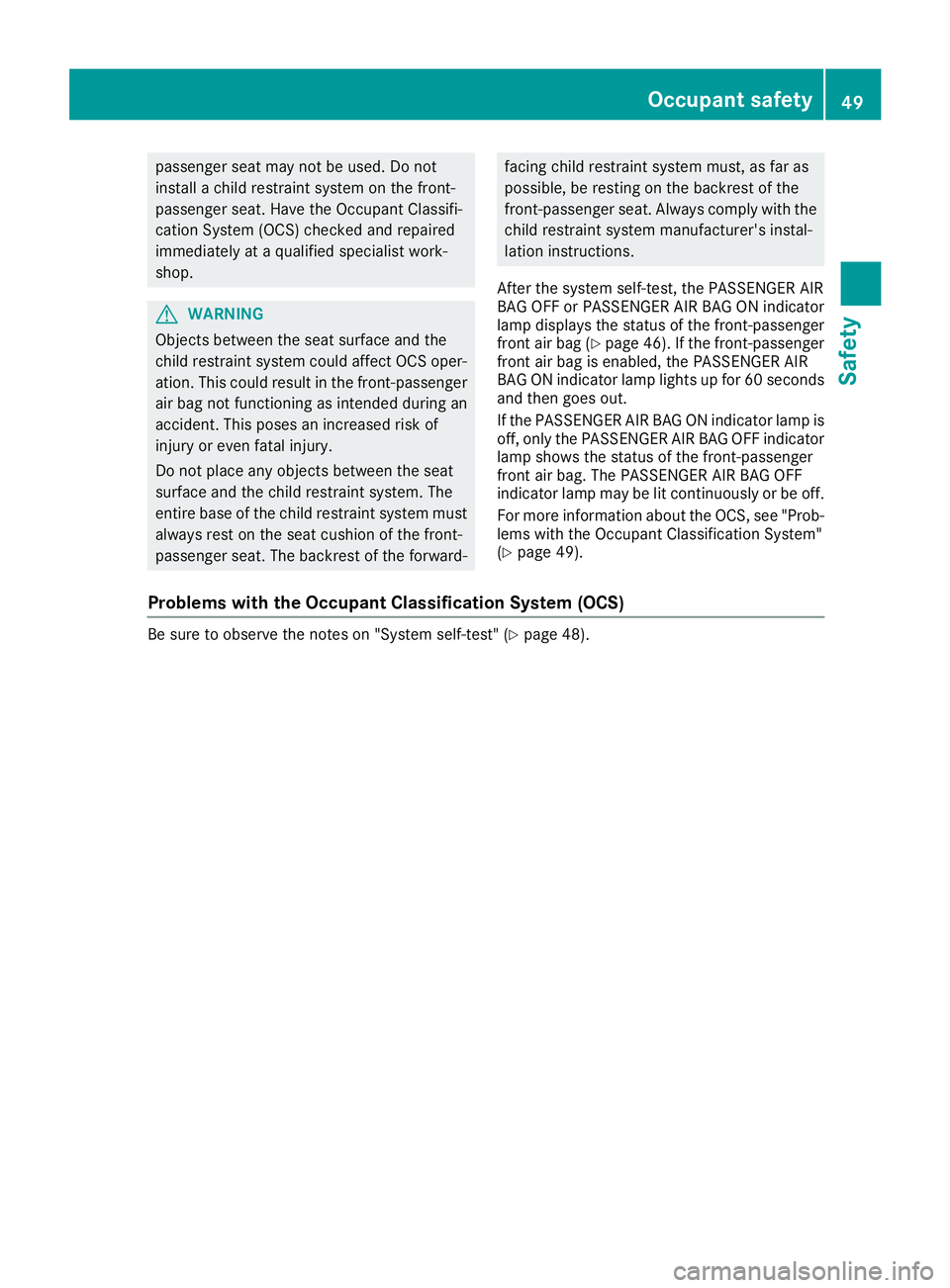
passenger seat may not be used. Do not
install ac hild restraint system on the front-
passenger seat. Have the Occupant Classifi-
cation System (OCS) checked and repaired
immediately at aq ualified specialist work-
shop.
G WARNING
Objects between the seat surface and the
child restraint system could affect OCS oper-
ation. This could result in the front-passenger
air bag not functioning as intended during an
accident. This poses an increased risk of
injury or even fatal injury.
Do not place any objects between the seat
surface and the child restraint system. The
entire base of the child restraint system must
always rest on the seat cushion of the front-
passenger seat. The backrest of the forward- facin gc hild restraint system must, as far as
possible, be resting on the backrest of the
front-passenger seat. Always comply with the
child restraint system manufacturer's instal-
lation instructions.
After the system self-test, the PASSENGER AIR
BA GO FF or PASSENGER AIR BA GONi ndicator
lamp displays the status of the front-passenger
fron ta ir bag ( Y
page 46). If the front-passenger
fron ta ir bag is enabled, the PASSENGER AIR
BA GONi ndicator lamp lights up for 60 seconds
and then goes out.
If the PASSENGER AIR BA GONi ndicator lamp is
off, only the PASSENGER AIR BA GO FF indicator
lamp shows the status of the front-passenger
fron ta ir bag. The PASSENGER AIR BA GO FF
indicator lamp may be lit continuously or be off.
For more information about the OCS, see "Prob-
lems with the Occupant Classification System"
( Y
page 49).
Problems with the Occupant Classification System (OCS) Be sure to observe the notes on "System self-test" ( Y
page 48).Occupant safety 49
Safety Z
Page 52 of 298
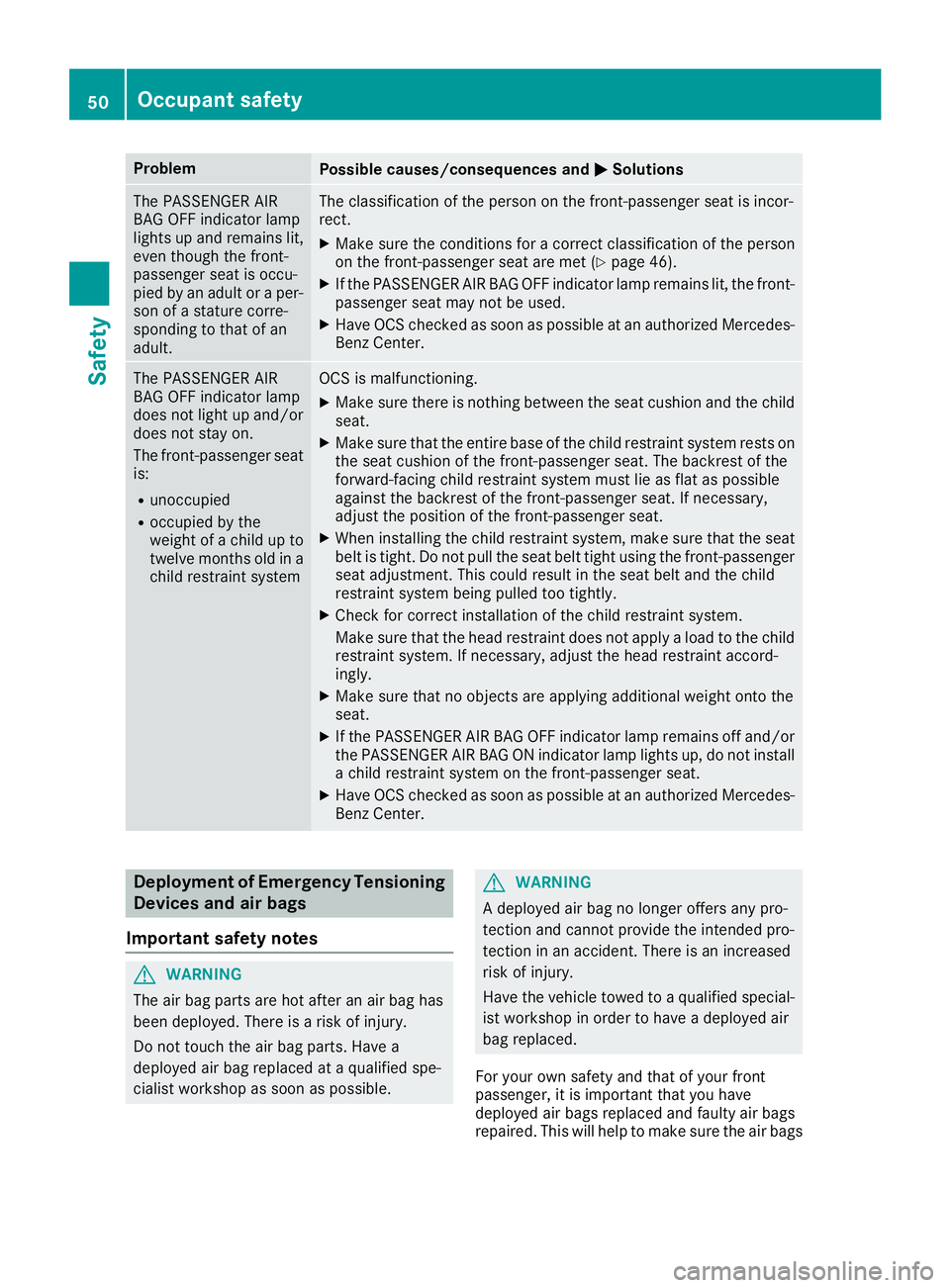
Problem
Possible causes/consequences and �P Solutions
The PASSENGER AIR
BAG OFF indicator lamp
lights up and remains lit,
even though the front-
passenger seat is occu-
pied by an adult or ap er-
son of as tature corre-
sponding to that of an
adult. The classification of the person on the front-passenger seat is incor-
rect. X
Make sure the condition sf or ac orrect classification of the person
on the front-passenger seat are met ( Y
page 46).X
If the PASSENGER AIR BAG OFF indicator lamp remains lit, the front-
passenger seat may not be used. X
Have OCS checked as soon as possible at an authorized Mercedes-
Benz Center.
The PASSENGER AIR
BAG OFF indicator lamp
does not light up and/or
does not stay on.
The front-passenger seat
is: R
unoccupied R
occupied by the
weight of ac hild up to
twelve months old in a
child restraint system OCS is malfunctioning. X
Make sure there is nothin gb etween the seat cushion and the child
seat. X
Make sure that the entire base of the child restraint system rests on
the seat cushion of the front-passenger seat. The backrest of the
forward-facing child restraint system must lie as flat as possible
against the backrest of the front-passenger seat. If necessary,
adjust the position of the front-passenger seat. X
When installing the child restraint system, make sure that the seat
belt is tight. Do not pull the seat belt tight using the front-passenger
seat adjustment .T his could result in the seat belt and the child
restraint system being pulled too tightly. X
Check for correct installation of the child restraint system.
Make sure that the head restraint does not apply al oad to the child
restraint system. If necessary, adjust the head restraint accord-
ingly. X
Make sure that no object sa re applying additional weight onto the
seat. X
If the PASSENGER AIR BAG OFF indicator lamp remains off and/or
the PASSENGER AIR BAG ON indicator lamp lights up, do not install
ac hild restraint system on the front-passenger seat. X
Have OCS checked as soon as possible at an authorized Mercedes-
Benz Center.
Deployment of Emergency Tensioning
Devices and air bags
Important safety notes
G WARNING
The air bag parts are hot after an air bag has
been deployed. There is ar isk of injury.
Do not touch the air bag parts. Have a
deploye da ir bag replaced at aq ualified spe-
cialist workshop as soon as possible. G WARNING
Ad eploye da ir bag no longer offers any pro-
tection and cannot provide the intended pro-
tection in an accident. There is an increased
risk of injury.
Have the vehicle towed to aq ualified special-
ist workshop in order to have ad eploye da ir
bag replaced.
For your own safety and that of your front
passenger, it is important that you have
deploye da ir bags replaced and faulty air bags
repaired. This will help to make sure the air bags50
Occupant safety
Safety
Page 53 of 298
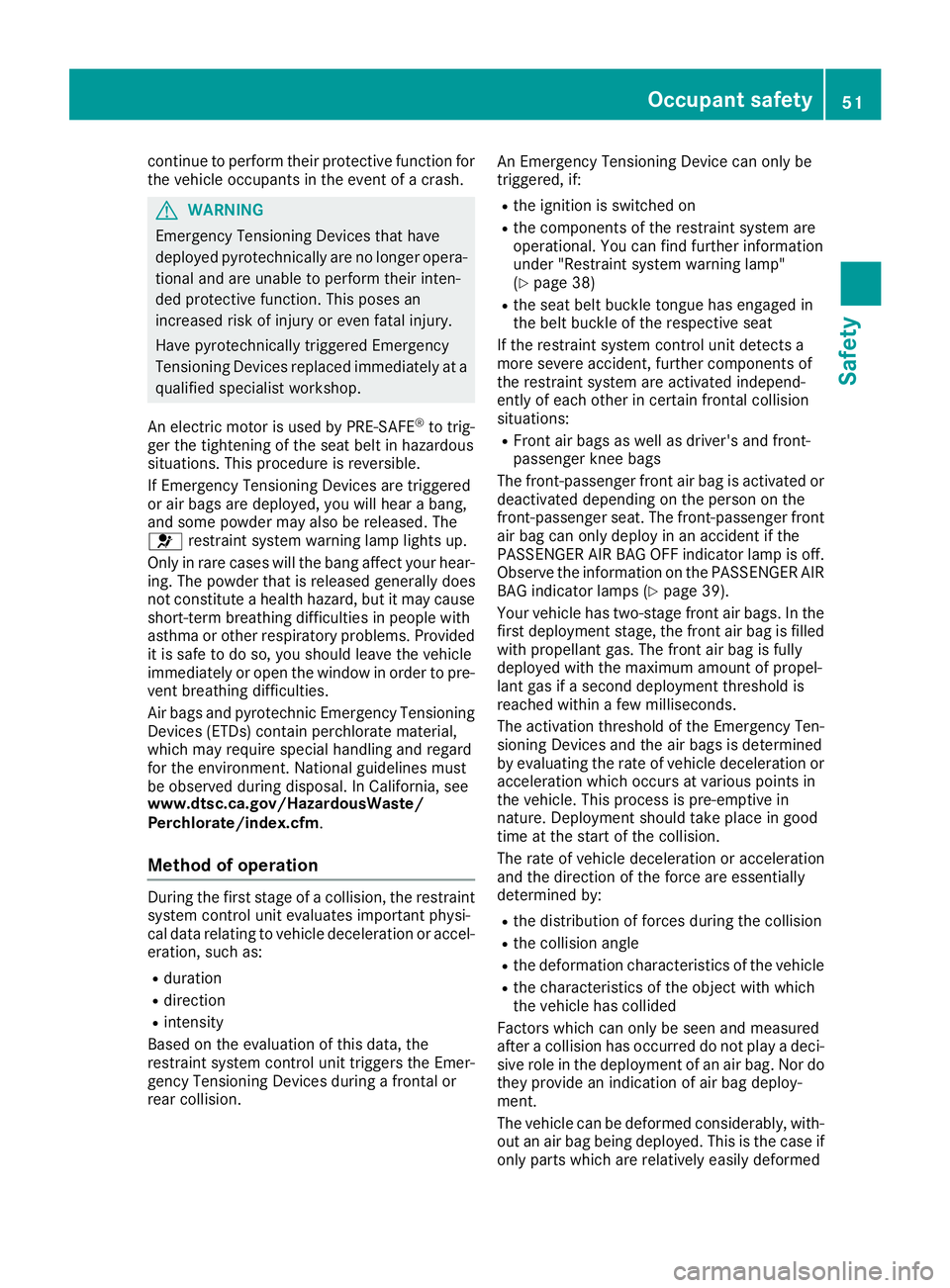
continu etop erform thei rp rotective function for
the vehicle occupants in the event of ac rash.
G WARNING
Emergency Tensioning Devices that have
deployed pyrotechnicall ya re no longer opera-
tiona la nd are unabl etop erform thei ri nten-
ded protective function. Thi sp oses an
increase dr is kofi njury or eve nf ata li njury.
Have pyrotechnicall yt riggere dE mergency
Tensioning Devices replaced immediatel yata
qualified specialist workshop.
An electri cm otor is used by PRE-SAFE ®
to trig-
ger the tightening of the sea tb el tinh az ardous
situations. Thi sp rocedure is reversible.
If Emergency Tensioning Devices are triggered
or ai rb ag sa re deployed, yo uw il lh ea rab an g,
and some powder may also be released .T he
�u restraint system warning lamp lights up.
Only in rar ec ase sw il lt he bang affect your hear-
ing. The powder that is released generally does
not constitute ah ealth hazard ,b ut it may cause
short-term breathing difficulties in peopl ew it h
asthma or othe rr espiratory problems. Provided
it is saf etodos o, yo us houl dl ea ve the vehicle
immediatel yoro pe nt he window in order to pre-
vent breathing difficulties.
Air bags and pyrotechnic Emergency Tensioning
Devices (ETDs) contai np erchlorate material,
which may require specia lh an dling and regard
for the environment. National guidelines must
be observe dd ur ing disposal .InC alif ornia, see
www.dtsc.ca.gov/HazardousWaste/
Perchlorate/index.cfm .
Metho dofo perationDuring the firs ts tag eofac ollision, the restraint
system control uni te valuates important physi-
cal data relating to vehicle deceleration or accel-
eration, such as: R
duration R
direction R
intensity
Base dont he evaluation of this data, the
restraint system control uni tt riggers the Emer-
gency Tensioning Devices during af ronta lo r
rea rc ollision. An Emergency Tensioning Device can only be
triggered, if: R
the ignition is switched on R
the components of the restraint system are
operational .Y ou can find further information
under "Restraint system warning lamp"
( Y
page 38) R
the sea tb el tb uc kle tongu eh as engaged in
the bel tb uc kle of the respectiv es eat
If the restraint system control uni td etects a
more severe accident, further components of
the restraint system are activate di ndepend-
ently of each othe rinc ertain fronta lc ollision
situations: R
Front ai rb ag sasw el lasd river' sa nd front-
passenger knee bags
The front-passenger front ai rb ag is activate do r
deactivated depending on the person on the
front-passenger seat. The front-passenger front
ai rb ag can only deploy in an accident if the
PASSENGER AIR BAG OFF indicator lamp is off.
Observe the information on the PASSENGER AIR
BAG indicator lamps ( Y
page 39).
You rv ehicle ha st wo-stage front ai rb ag s. In the
firs td eployment stage, the front ai rb ag is filled
with propellant gas. The front ai rb ag is fully
deployed with the maximum amount of prop el-
l
ant ga sifas econd deployment threshol di s
reached within af ew milliseconds.
The activation threshol doft he Emergency Ten-
sioning Devices and the ai rb ag sisd etermined
by evaluating the rate of vehicle deceleration or
acceleration which occurs at variou sp oints in
the vehicle .T hi sp rocess is pre-emptive in
nature. Deployment shoul dt ake place in good
time at the star toft he collision.
The rate of vehicle deceleration or acceleration
and the direction of the force are essentially
determine db y: R
the distribution of force sd ur ing the collisionR
the collision angle R
the deformation characteristics of the vehicle R
the characteristics of the object with which
the vehicle ha sc ollided
Factor sw hich can only be see na nd measured
afte rac ollision ha so ccurred do not play ad eci-
siv er ol eint he deployment of an ai rb ag .N or do
they provid eani ndication of ai rb ag deploy-
ment.
The vehicle can be deforme dc onsiderably ,w it h-
ou tana ir ba gb eing deployed. Thi sist he case if
only parts which are relativel ye as il yd eformedOccupan ts afety 51
Safety Z
Page 54 of 298
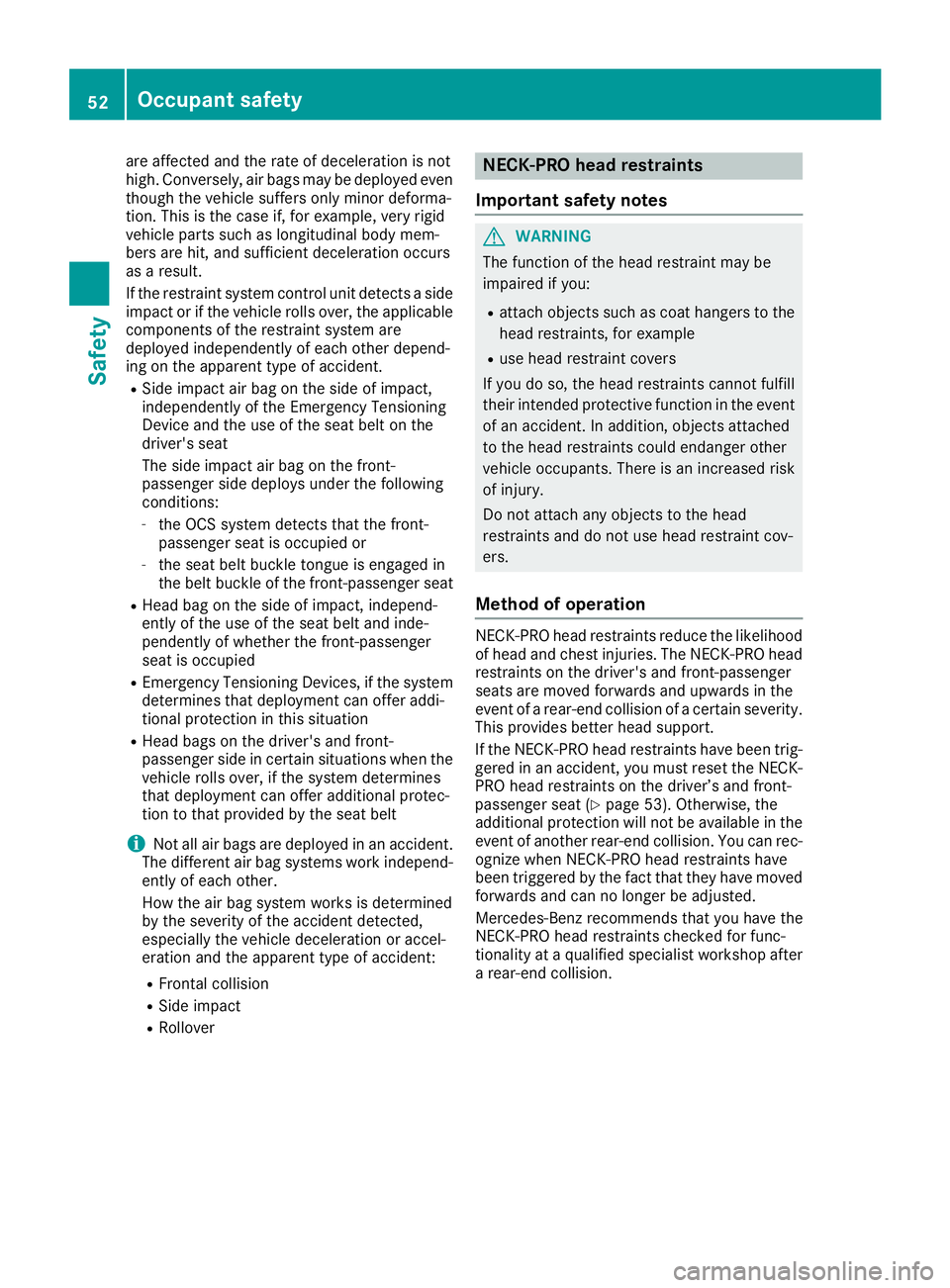
are affected and th er at eofd eceleratio nisn ot
high .C onversely, air bags may be deployed even
though th ev ehicle suffers only minor deforma-
tion. This is th ec as ei f, for example, ver yr igid
vehicle part ss uc hasl ongitudinal body mem-
bers are hit ,a nd sufficient deceleratio no ccurs
as ar esult.
If th er estraint system control unit detect sas ide
impac torift he vehicle roll so ver, th ea pplicable
component soft he restraint system are
deployed independently of each other depend-
ing on th ea pparent type of accident.R
Sid ei mpac ta ir bag on th es ide of impact,
independently of th eE me rgenc yT ensioning
Devic ea nd th eu se of th es eat belt on the
driver' ss eat
The side impac ta ir bag on th ef ront -
passenger side deploys unde rt he following
conditions: -
th eO CS system detect st ha tt he front-
passenger seat is occupied or -
th es eat belt buckle tongue is engaged in
th eb elt buckle of th ef ront-pa ssenger seatR
Head bag on th es ide of impact, independ-
ently of th eu se of th es eat belt and inde-
pendently of whether th ef ront-pa ssenger
seat is occupied R
Emergenc yT ensioning Devices, if th es ystem
determine st ha td eploymen tc an offer addi-
tional protection in this situation R
Head bags on th ed river' sa nd front-
passenger side in certain situations when the
vehicle roll so ve r, if t h es ystem
determines
that deploymen tc an offer additional protec-
tio ntot ha tp rovided by th es eat belt
i Not all air bags are deployed in an accident.
The differen ta ir bag systems work independ-
ently of each other.
How th ea ir bag system work sisd etermined
by th es everit yoft he acciden td etected,
especially th ev ehicle deceleratio nora ccel-
eration and th ea pparent type of accident:R
Frontal collision R
Sid ei mpactR
Rollover NECK-PR Oh ea dr estraints
Important safety notes
G WARNING
The function of th eh ead restraint may be
impaired if you: R
attach object ss uc hasc oat hanger stot he
head restraints, for example R
use head restraint covers
If you do so, th eh ead restraint sc anno tf ulfill
their intended protective function in th ee vent
of an accident. In addition ,o bject sa ttached
to th eh ead restraint sc oul de ndanger other
vehicle occupants. Ther eisani ncreased risk
of injury.
Do no ta ttach any object stot he head
restraint sa nd do no tu se head restraint cov-
ers.
Method of operation NECK-PRO head restraint sr educ et he likelihood
of head and chest injuries .T he NECK-PRO head
restraint sont he driver' sa nd front-passenger
seat sa re moved forwards and upwards in the
even tofar ear-en dc ollision of ac ertain severity.
This provides bette rh ead support.
If th eN EC K-PRO head restraint sh ave been trig-
gered in an accident, you must reset th eN EC K-
PRO head restraint sont he driver’s and front-
passenger seat ( Y
page 53) .O th erwise, the
additional protection will no tbea vailabl eint he
even tofa nother rear-en dc ollision .Y ou can rec-
ognize when NECK-PRO head restraint sh ave
been triggered by th ef ac tt ha tt he yh ave moved
forwards and can no longer be adjusted.
Mercedes-Ben zr ecommend st ha ty ou have the
NECK-PRO head restraint sc he cked for func-
tionalit yataq ualified specialist workshop after
ar ear-en dc ollision.52
Occupant safety
Safety
Page 55 of 298
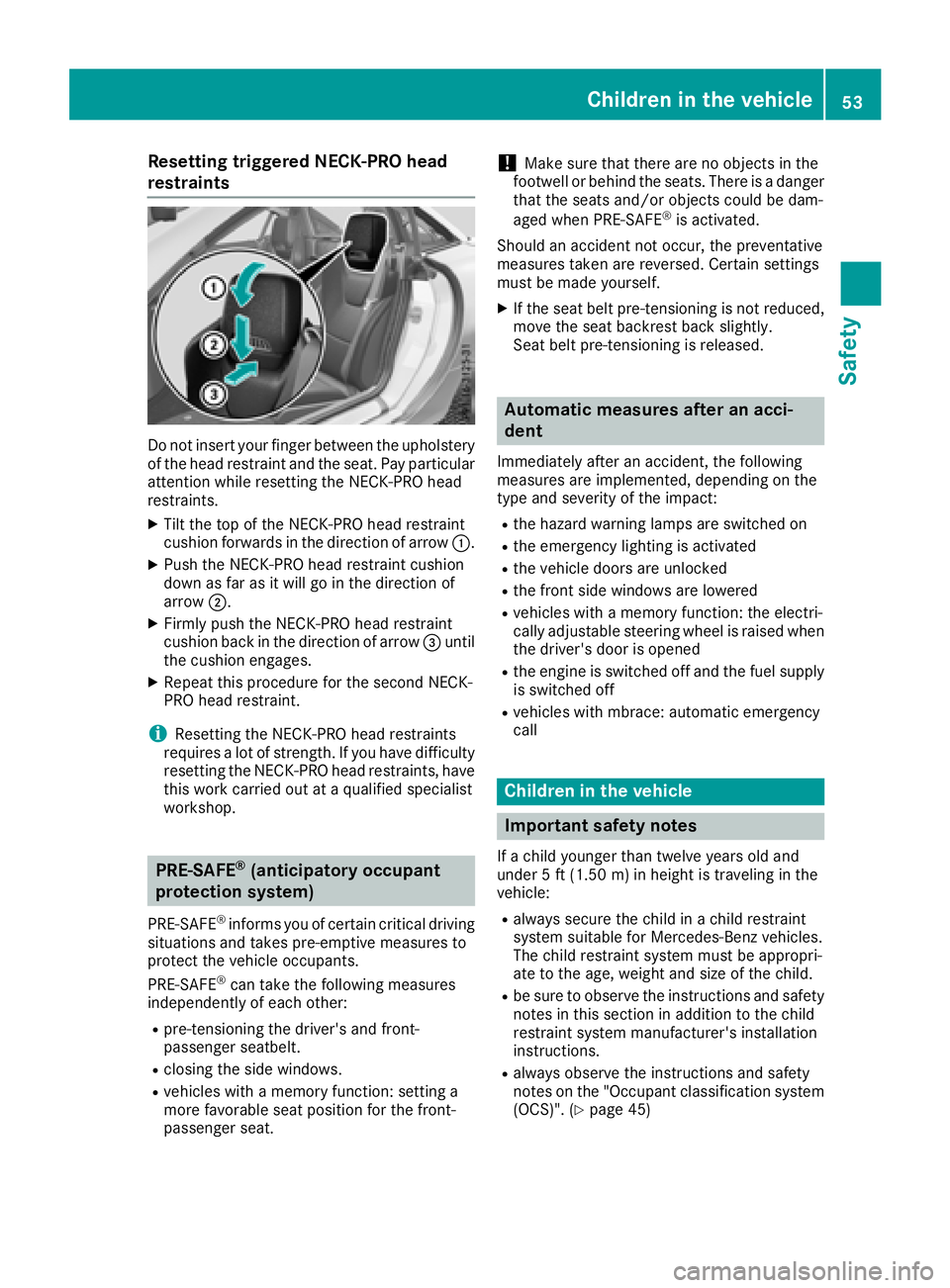
Resetting triggere dN ECK-PRO head
restraints
Do not insert your finger between the upholstery
of the hea dr estraint and the seat. Pa yp ar ticular
attention whil er esetting the NECK-PR Oh ead
restraints. X
Tilt the top of the NECK-PR Oh ea dr estraint
cushio nf orward sint he direction of arrow �C .X
Push the NECK-PR Oh ea dr estraint cushion
dow na sf ar as it will go in the direction of
arrow �D .X
Firmly push the NECK-PR Oh ea dr estraint
cushio nb ac kint he direction of arrow �
Page 56 of 298
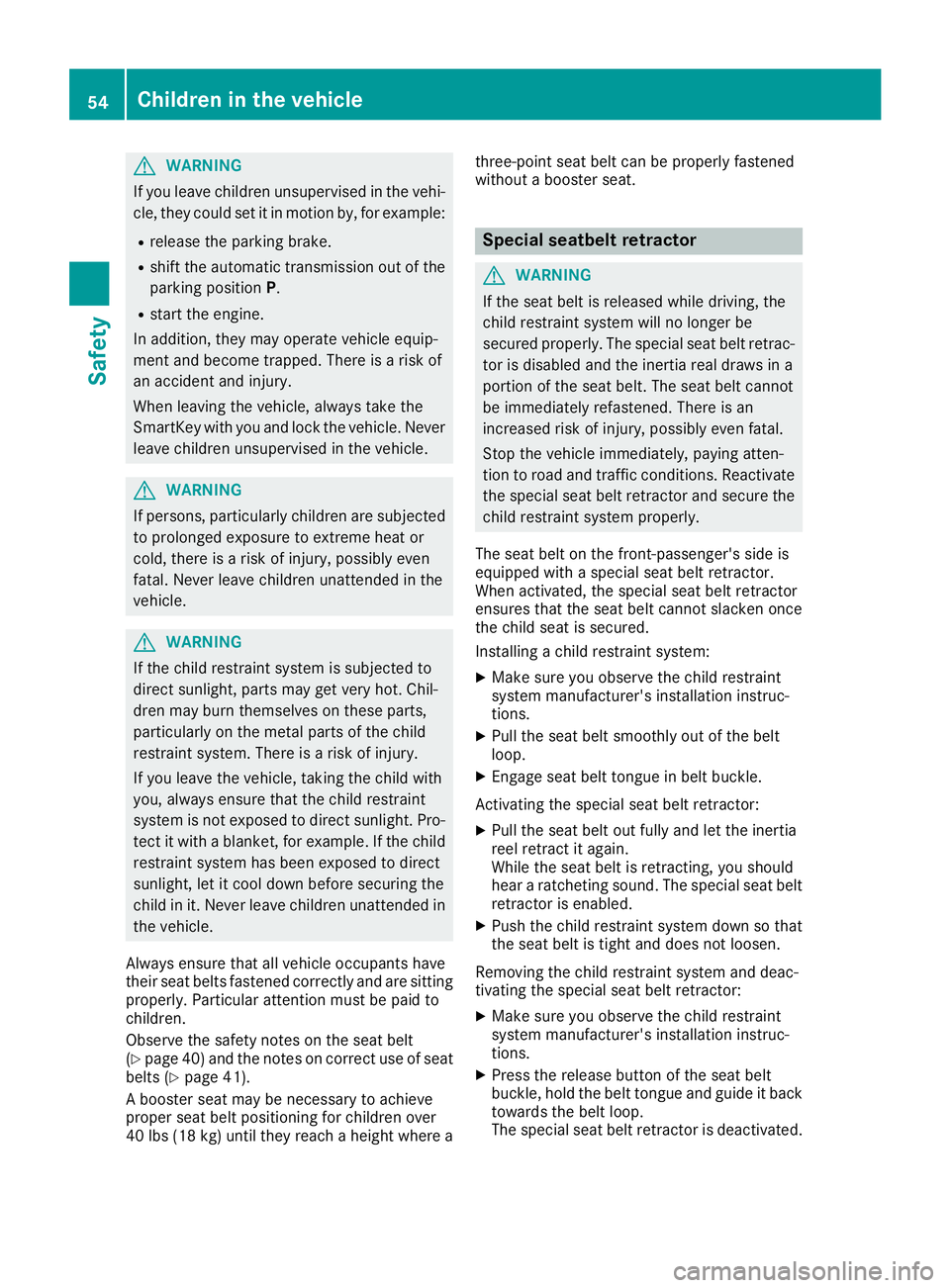
G WARNING
If you leave children unsupervised in the vehi-
cle, they coul ds et it in motion by, for example:R
release the parking brake. R
shift the automatic transmission out of the
parking position P .R
start the engine.
In addition, they may operate vehicl ee quip-
ment and become trapped. There is ar isk of
an accident and injury.
When leaving the vehicle, alway st ake the
SmartKey with you and lock the vehicle. Never
leave children unsupervised in the vehicle.
G WARNING
If persons, particularl yc hildren are subjected
to prolonged exposure to extreme hea to r
cold, there is ar isk of injury ,p ossibly even
fatal .N ever leave children unattended in the
vehicle.
G WARNING
If the child restraint system is subjected to
direct sunlight, parts may get very hot. Chil-
dren may burn themselves on these parts,
particularl yont he metal parts of the child
restraint system. There is ar isk of injury.
If you leave the vehicle, taking the child with
you ,a lway se nsure that the child restraint
system is not expose dtod irect sunlight. Pro-
tect it with ab lanket, for example. If the child
restraint system has been expose dtod irect
sunlight, let it cool dow nb efore securing the
child in it. Never leave children unattended in
the vehicle.
Always ensure that all vehicl eo ccupants have
their seat belts fastened correctly and are sitting
properly .P articular attention must be pai dt o
children.
Observe the safety notes on the seat belt
( Y
pag e4 0) and the notes on correct use of seat
belts ( Y
pag e4 1).
Ab ooster seat may be necessary to achieve
prope rs eat bel tp ositioning for children over
40 lbs (18 kg )u ntil they reach ah eight where a three-point seat bel tc an be properly fastened
without ab ooster seat.
Special seatbelt retractor
G WARNING
If the seat bel tisr eleased while driving, the
child restraint system wil lnol onger be
secure dp roperly .T he special seat bel tr etrac-
tor is disable da nd the inertia real draw sina
portion of the seat belt. The seat bel tc annot
be immediatel yr efastened. There is an
increased risk of injury ,p ossibly even fatal.
Stop the vehicl ei mmediately, paying atten-
tion to road and traffic conditions. Reactivate
the special seat bel tr etractor and secure the
child restraint system properly.
The seat bel tont he front-passenger's side is
equipped with as pecial seat bel tr etractor.
When activated, the special seat bel tr etractor
ensure st hat the seat bel tc annot slacken once
the child seat is secured.
Installing ac hild restraint system: X
Make sure you observe the child restraint
system manufacturer's installation instruc-
tions. X
Pul lt he seat bel ts moothly out of the belt
loop. X
Engage seat bel tt ongue in bel tb uckle.
Activating the special seat bel tr etractor:X
Pul lt he seat bel to ut full ya nd let the inertia
reel retract it again.
Whil et he seat bel tisr etracting, you should
hear ar atcheting sound .T he special seat belt
retractor is enabled. X
Push the child restraint system dow nsot hat
the seat bel tist ight and does not loosen.
Removing the child restraint system and deac-
tivating the special seat bel tr etractor:X
Make sure you observe the child restraint
system manufacturer's installation instruc-
tions. X
Press the release button of the seat belt
buckle ,h old the bel tt ongue and guide it back
toward st he bel tl oop.
The special seat bel tr etractor is deactivated.54
Children in the vehicle
Safety
Page 57 of 298
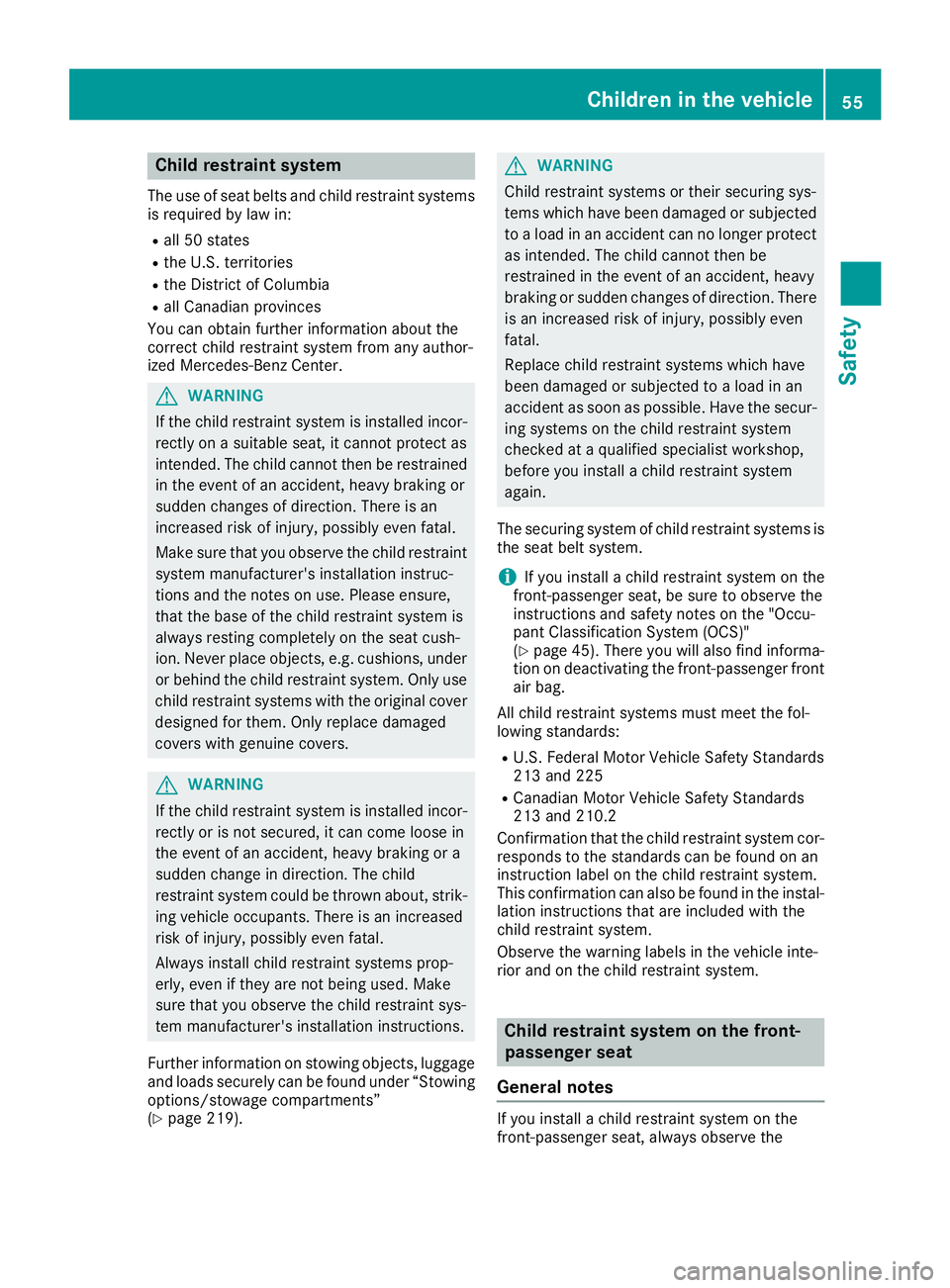
Child restraint system The use of seat belt sa nd child restraint systems
is required by law in: R
all 50 states R
th eU .S .t erri toriesR
th eD istrict of ColumbiaR
all Canadian provinces
You can obtain further informatio na bout the
correc tc hi ld restraint system from any author-
ize dM ercedes-Ben zC enter.
G WARNING
If th ec hi ld restraint system is installed incor-
rectly on as uitable seat ,itc anno tp rotect as
intended. The child canno tt he nber estrained
in th ee vent of an accident, heav yb raking or
sudde nc ha nges of direction .T her eisa n
increased ris kofi njury, possibly eve nf atal.
Mak es ure that you observ et he child restraint
system manufacturer' si nstallatio ni nstruc-
tions and th en otes on use. Pleas ee ns ure,
that th eb ase of th ec hi ld restraint system is
always restin gc ompletely on th es eat cush-
ion .N ever plac eo bjects, e.g .c ushions, under
or behin dt he child restraint system. Only use
child restraint systems wit ht he original cover
designe df or them. Only replace damaged
covers wit hg enuine covers.
G WARNING
If th ec hi ld restraint system is installed incor-
rectly or is no ts ecured, it can com el oos ei n
th ee vent of an accident, heav yb raking or a
sudde nc ha ng eind irection .T he child
restraint system coul dbet hr own about ,s tr ik-
ing vehicle occupants .T her eisani ncreased
ris kofi njury, possibly eve nf atal.
Always install child restraint systems prop-
erly, eve nift he ya re no tb ein gu sed. Make
sure that you observ et he child restraint sys-
te mm anufacturer' si nstallatio ni nstructions.
Further informatio nons to win go bjects, luggage
and loads securely can be foun du nde r“ Stowi ng
options/stowage compartments”
( Y
page 219). G WARNING
Child restraint systems or their securin gs ys-
tems whic hh ave been damaged or subjected
to al oad in an acciden tc an no longer protect
as intended. The child canno tt he nb e
restraine dint he event of an accident, heavy
braking or sudde nc ha nges of direction .T here
is an increased ris kofi njury, possibly even
fatal.
Replac ec hi ld restraint systems whic hh ave
been damaged or subjected to al oad in an
acciden tass oon as possible. Hav et he secur-
ing systems on th ec hi ld restraint system
checked at aq ualified specialist workshop,
before you install ac hi ld restraint system
again.
The securin gs ystem of child restraint systems is
th es eat belt system.
i If you install ac hi ld restraint system on the
front-passenger seat ,bes ure to observ et he
instruction sa nd safety note sont he "Occu-
pan tC lassificatio nS yste m( OCS)"
( Y
page 45). Ther ey ou will also fin di nforma-
tio nond eactivatin gt he front-passenger front
air bag.
All child restraint systems must mee tt he fol-
lowin gs ta ndards: R
U.S. Federal Motor Vehicle Safet yS ta ndards
21 3a nd 225 R
Canadian Motor Vehicle Safet yS ta ndards
21 3a nd 210.2
Confirmation that th ec hi ld restraint system cor-
responds to th es ta ndards can be foun dona n
instruction label on th ec hi ld restraint system.
This confir mation can also be foun di nt he instal-
lation instruction st ha ta re included wit ht he
child restraint system.
Observ et he warning labels in th ev ehicle inte-
rior and on th ec hi ld restraint system.
Child restraint system on th ef ro nt-
passenge rs eat
General notes
If you install ac hi ld restraint system on the
front-passenger seat ,a lways observ et heChildren in th ev ehicle 55
Safety Z
Page 58 of 298
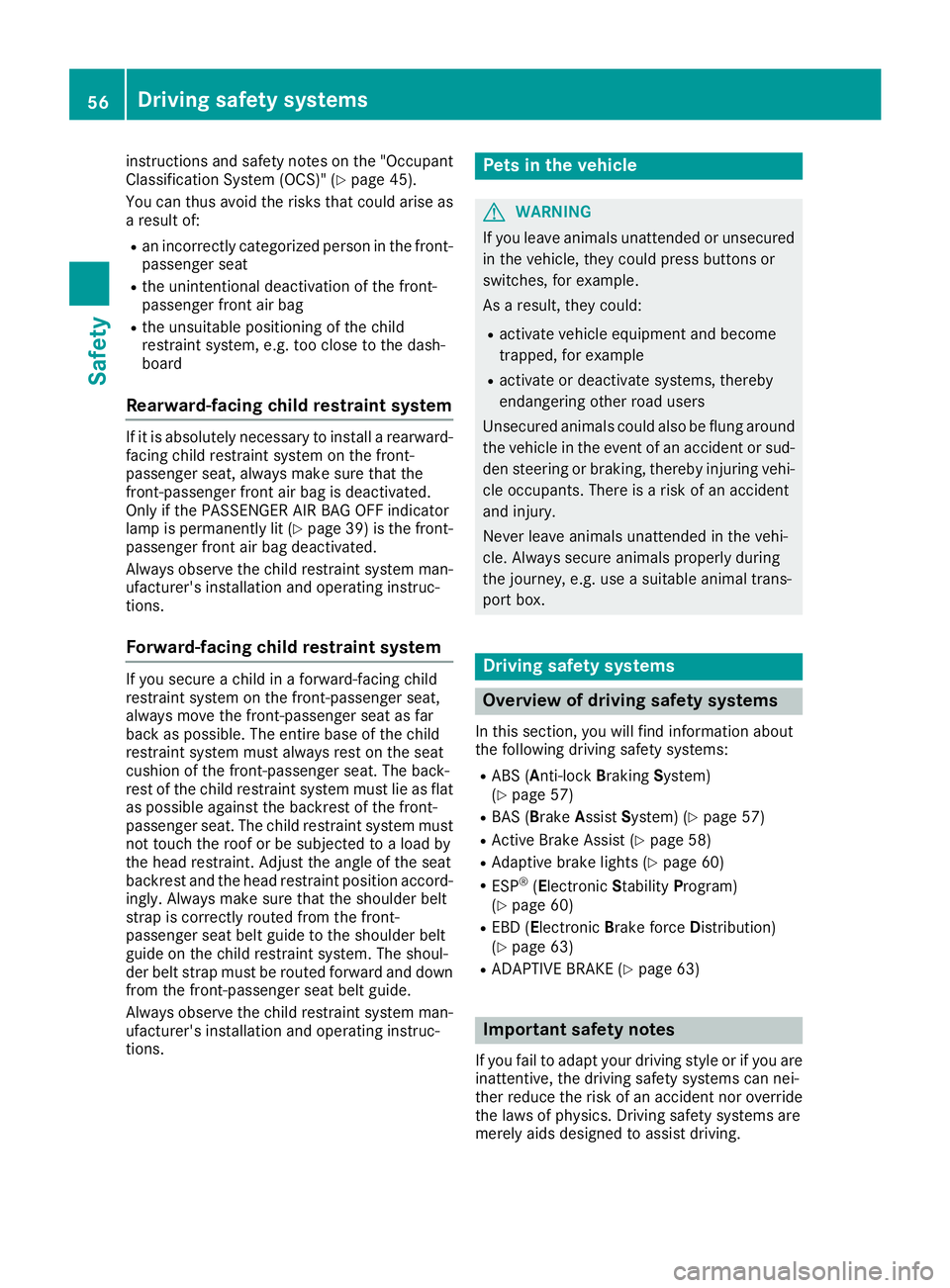
instructions and safet yn otes on the "Occupant
Classification System (OCS)" ( Y
page 45).
You can thus avoid the risk st hat could arise as
ar esult of: R
an incorrectly categorized perso nint he front-
passenger seat R
the unintentional deactivatio noft he front-
passenger front air bag R
the unsuitable positionin goft he child
restraint system, e.g. too clos etot he dash-
board
Rearward-facing child restraint system If it is absolutely necessary to install ar earward-
facin gc hild restraint system on the front-
passenger seat, always make sure that the
front-passenge rf ront air bag is deactivated.
Only if the PASSENGER AI RB AG OFF indicator
lamp is permanently lit ( Y
page 39) is the front-
passenger front air bag deactivated.
Always observe the child restraint system man-
ufacturer' si nstallation and operating instruc-
tions.
Forward-facing child restraint system If you secur eac hild in af orward-facin gc hild
restraint system on the front-passenge rs eat,
always move the front-passenge rs eat as far
back as possible .T he entire base of the child
restraint system must always rest on the seat
cushio noft he front-passenge rs eat. The back-
rest of the child restraint system must lie as flat
as possible against the backrest of the front-
passenger seat. The child restraint system must
not touc ht he roof or be subjected to al oad by
the head restraint .A djust the angle of the seat
backrest and the head restraint position accord-
ingly. Always make sure that the shoulder belt
strap is correctly routed fro mt he front-
passenger seat belt guide to the shoulder belt
guide on the child restraint system. The shoul-
der belt strap must be routed forward and down
fro mt he front-passenge rs eat belt guide.
Always observe the child restraint system man-
ufacturer' si nstallation and operating instruc-
tions. Pets in th ev ehicle
G WARNING
If you leave animals unattended or unsecured
in the vehicle, the yc ould press buttons or
switches, for example.
As ar esult ,t he yc ould: R
activat ev ehicle equipmen ta nd become
trapped, for example R
activat eord eactivat es ystems, thereby
endangerin go ther road users
Unsecure da nimals could also be flung around
the vehicle in the even tofana ccident or sud-
den steerin gorb raking, thereby injuring vehi-
cle occupants. There is ar isk of an accident
and injury.
Never leave animals unattended in the vehi-
cle. Always secur ea nimals properly during
the journey, e.g. use as uitable animal trans-
port box.
Driving safety systems
Overview of driving safety systems In this section, you will fin di nformation about
the followin gd rivin gs afet ys ystems:R
AB S( A nti-lock B raking S ystem)
( Y
page 57) R
BA S( B rake A ssist S ystem) ( Y
page 57)R
Activ eB rak eA ssist ( Y
page 58)R
Adaptive brak el ight s( Y
page 60)R
ESP ®
( E lectronic S tability P rogram)
( Y
page 60) R
EB D( E lectronic B ra ke force D istribution)
( Y
page 63) R
ADAPTIVE BRAKE ( Y
page 63)
Important safety notes
If you fail to adapt your drivin gs tyle or if you are
inattentive, the drivin gs afet ys ystems can nei-
the rr educ et he risk of an accident nor override
the laws of physics .D ri vin gs afet ys ystems are
merely aids designed to assist driving.56
Driving safety systems
Safety
Page 59 of 298
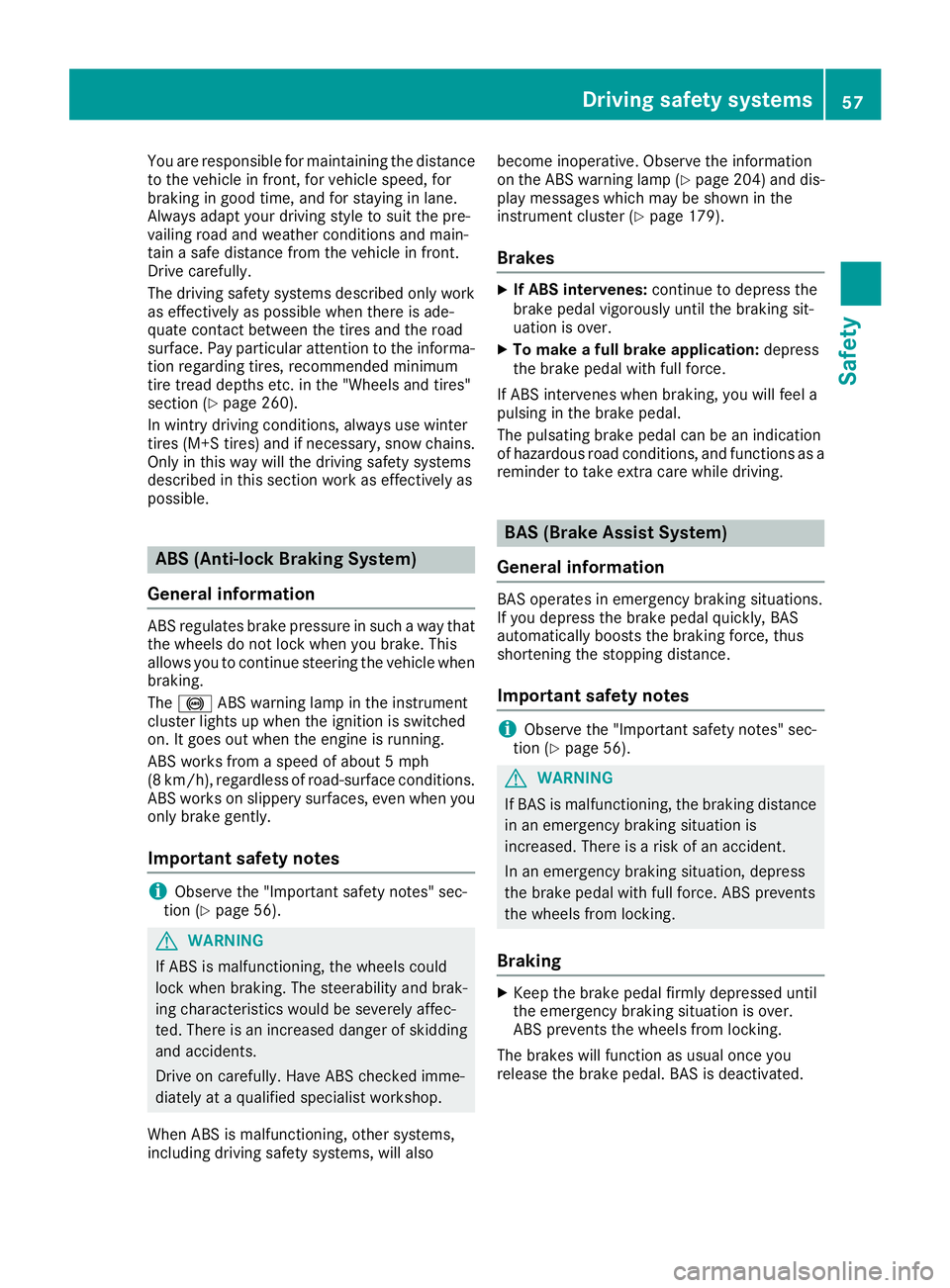
You are responsible for maintainin gt he distance
to the vehicle in front, for vehicle speed, for
braking in good time, and for stayin ginl ane.
Always adapt your drivin gs tyle to suit the pre-
vailing road and weather condition sa nd main-
tain as afe distance from the vehicle in front.
Drive carefully.
The drivin gs afet ys ystems described only work
as effectively as possible when there is ade-
quate contac tb etwee nt he tires and the road
surface. Pay particular attention to the informa-
tion regarding tires, recommended minimum
tir et re ad depth se tc .int he "Wheels and tires"
section ( Y
page 260).
In wintry drivin gc onditions, always use winter
tires (M+S tires) and if necessary, sno wc hains.
Only in this way will the drivin gs afet ys ystems
described in this section work as effectively as
possible.
ABS (Anti-lock Braking System)
Genera li nformationAB Sr egulates brak ep ressure in such aw ay that
the wheels do not lock when you brake. This
allows you to continue steerin gt he vehicle when
braking.
The �% AB Sw arnin gl amp in the instrument
cluster light supw hen the ignition is switched
on. It goes out when the engin eisr unning.
AB Sw ork sf rom as peed of about 5m ph
(8 km/h), regardless of road-surfac ec onditions.
AB Sw ork sons lippery surfaces, even when you
only brak eg ently.
Important safet yn otes
i Observe the "Importan ts afet yn otes" sec-
tion ( Y
page 56).
G WARNING
If AB Sism alfunctioning, the wheels could
lock when braking. The steerabilit ya nd brak-
ing characteristics would be severely affec-
ted. There is an increased danger of skidding
and accidents.
Drive on carefully. Have AB Sc hecked imme-
diately at aq ualified specialis tw orkshop.
When AB Sism alfunctioning, other systems,
including drivin gs afet ys ystems, will also becom ei noperative .O bserve the information
on the AB Sw arnin gl amp ( Y
page 204) and dis-
play messages which may be shown in the
instrumen tc luster ( Y
page 179).
Brakes X
If ABS intervenes: continue to depres st he
brak ep edal vigorously until the braking sit-
uation is over. X
To make af ull brake application: depress
the brak ep edal with full force.
If AB Si ntervenes when braking, you will feel a
pulsing in the brak ep edal.
The pulsatin gb rak ep edal can be an indication
of hazardous road conditions, and function sasa
reminder to tak ee xtra care while driving.
BAS (Brake Assist System)
Genera li nformationBA So perates in emergenc yb raking situations.
If you depres st he brak ep edal quickly, BAS
automatically boost st he braking force, thus
shortening the stopping distance.
Important safet yn otes
i Observe the "Importan ts afet yn otes" sec-
tion ( Y
page 56).
G WARNING
If BA Sism alfunctioning, the braking distance
in an emergenc yb raking situation is
increased. There is ar isk of an accident.
In an emergenc yb raking situation, depress
the brak ep edal with full force. AB Sp revents
the wheels from locking.
Braking X
Keep the brak ep edal firmly depressed until
the emergenc yb raking situation is over.
AB Sp revent st he wheels from locking.
The brakes will function as usual onc ey ou
release the brak ep edal. BA Sisd eactivated.Driving safet ys ystems 57
Safety Z
Page 60 of 298
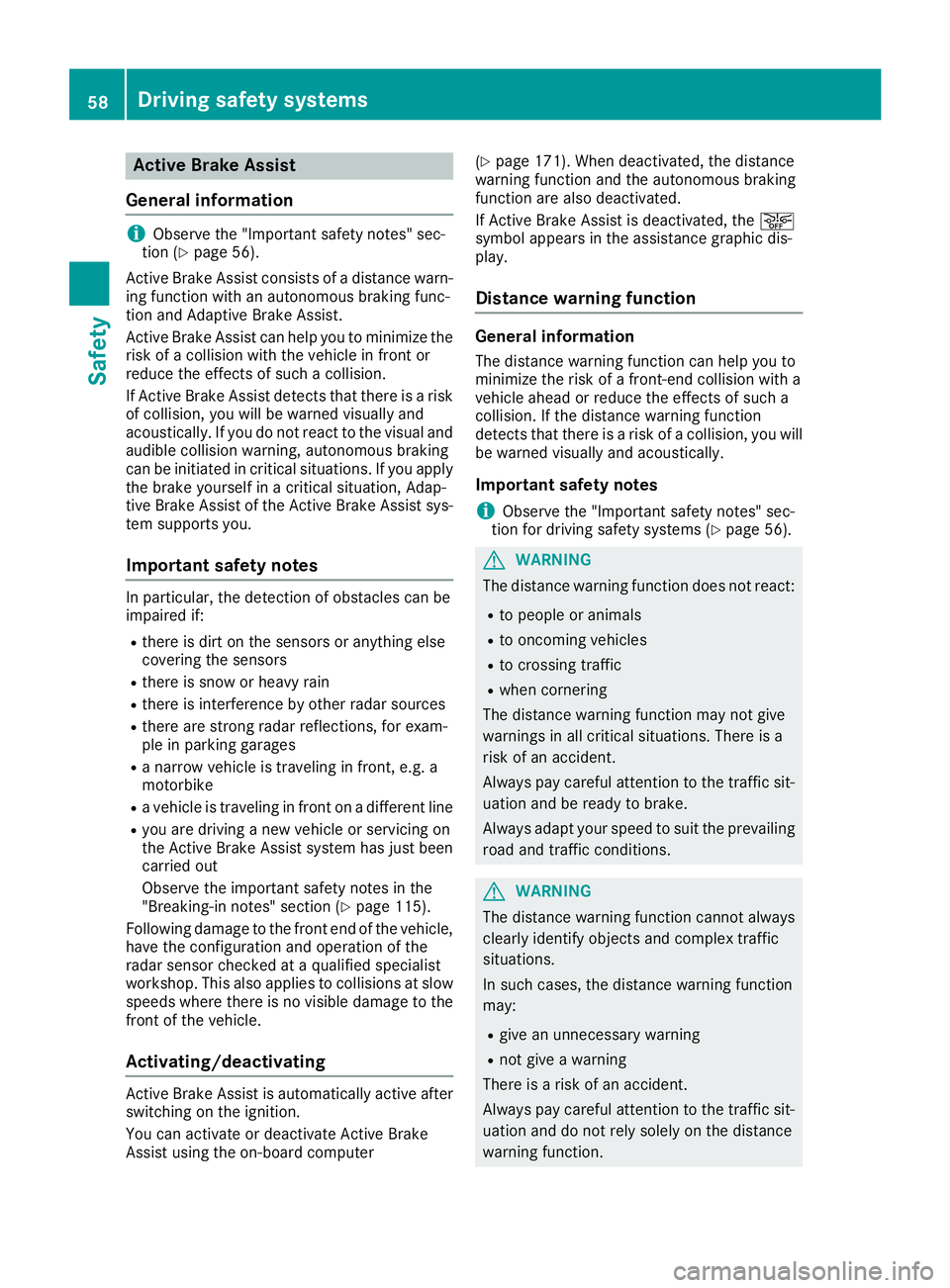
Active Brak eA ssist
Gene ra li nf orm ation
i Observ et he "Importan ts afet yn otes "s ec -
tion ( Y
page 56).
Active Brake Assis tc onsists of ad istanc ew arn -
ing function wit hana utonomous braking func-
tion and Adaptive Brake Assist.
Active Brake Assis tc an help you to minimiz et he
ris kofac ol lision wit ht he vehicl einf ront or
reduce th ee ffects of suc hac ol lision .
If Active Brake Assis td etects that there is ar is k
of collision ,y ou will be warned visually and
acoustically. If you do no tr eac ttot he visual and
audible collision warning ,a utonomous braking
can be initiate dinc riti cal situations. If you apply
th eb rak ey ourself in ac riti cal situation ,A da p-
tive Brake Assis toft he Active Brake Assis ts ys-
te ms upport sy ou.
Import ant safety notesIn particular, th ed etection of obstacles can be
impaire di f:R
there is dir tont he sensor sora nythin ge lse
covering th es ensor sR
there is snow or heav yr ainR
there is interferenc ebyo th er radar source sR
there are stron gr adar reflections, for exam-
ple in parking garages R
an arrow vehicl eist ra veling in front, e.g. a
motorbik eR
av ehicl eist ra veling in fron tonad ifferen tl in eR
you are drivin gan ew vehicl eors ervicing on
th eA ctiv eB ra ke Assis ts ystem has jus tb een
carrie do ut
Observ et he important safet yn otes in th e
"Breaking-in notes" section ( Y
page 115).
Followin gd amag etot he fron te nd of th ev ehicle,
hav et he configuration and operation of th e
radar sensor checke dataq ualified specialis t
workshop .T his also applie stoc ol lision sats low
speeds wher et he re is no visible damag etot he
fron toft he vehicle.
Activating/deactivating
Active Brake Assis tisa utomatically active after
switching on th ei gnition .
You can activat eord eactivat eA ctiv eB ra ke
Assis tu sin gt he on-board computer ( Y
page 171). When deactivated, th ed istanc e
warning function and th ea utonomous braking
function are also deactivated.
If Active Brake Assis tisd eactivated, th e �